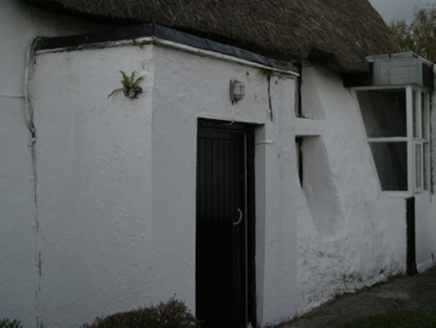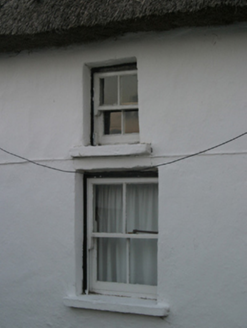Survey Data
Reg No
15704868
Rating
Regional
Categories of Special Interest
Architectural, Social
Original Use
Farm house
In Use As
Farm house
Date
1700 - 1840
Coordinates
306764, 108595
Date Recorded
23/10/2007
Date Updated
--/--/--
Description
Detached four-bay single-storey lobby entry thatched farmhouse with dormer attic, extant 1840, on a rectangular plan originally three-bay single-storey on a T-shaped plan centred on single-bay single-storey flat-roofed projecting porch. Extended, pre-1903, producing present composition. "Restored", ----. For sale, 2009. Replacement hipped oat thatch roof with exposed hazel lattice stretchers to raised ridge having exposed scallops, cement rendered off-central chimney stack having concrete capping supporting terracotta pots, and part exposed hazel stretchers to eaves having exposed scallops. Limewashed rendered battered walls. Square-headed central door opening with concealed dressings framing replacement timber boarded or tongue-and-groove timber panelled door. Square-headed window openings with limewashed concrete or rendered sills, and concealed dressings framing two-over-two timber sash windows having part exposed sash boxes with six-over-six timber sash windows to gables to side elevations having part exposed sash boxes Set back from line of road on a corner site with limewashed cylindrical piers to perimeter having conical capping supporting flat iron double gates.
Appraisal
A farmhouse identified as an integral component of the vernacular heritage of south County Wexford by such attributes as the lobby entry plan form centred on an expressed porch; the construction in unrefined local materials displaying a battered silhouette with sections of "daub" or mud suggested by an entry in the "House and Building Return" Form of the National Census (NA 1901; NA 1911); the somewhat disproportionate bias of solid to void in the massing; and the high pitched roof showing a replenished oat thatch finish: meanwhile, aspects of the composition, in particular an apparent "masonry break", clearly illustrate the continued linear development of the farmhouse in the later nineteenth century. Having been well maintained, the elementary form and massing survive intact together with quantities of original fabric, both to the exterior and to the interior, thus upholding the character or integrity of a farmhouse forming part of a self-contained group alongside an opposing farmhouse (see 15704869) with the resulting ensemble making a pleasing visual statement in a sylvan street scene.













